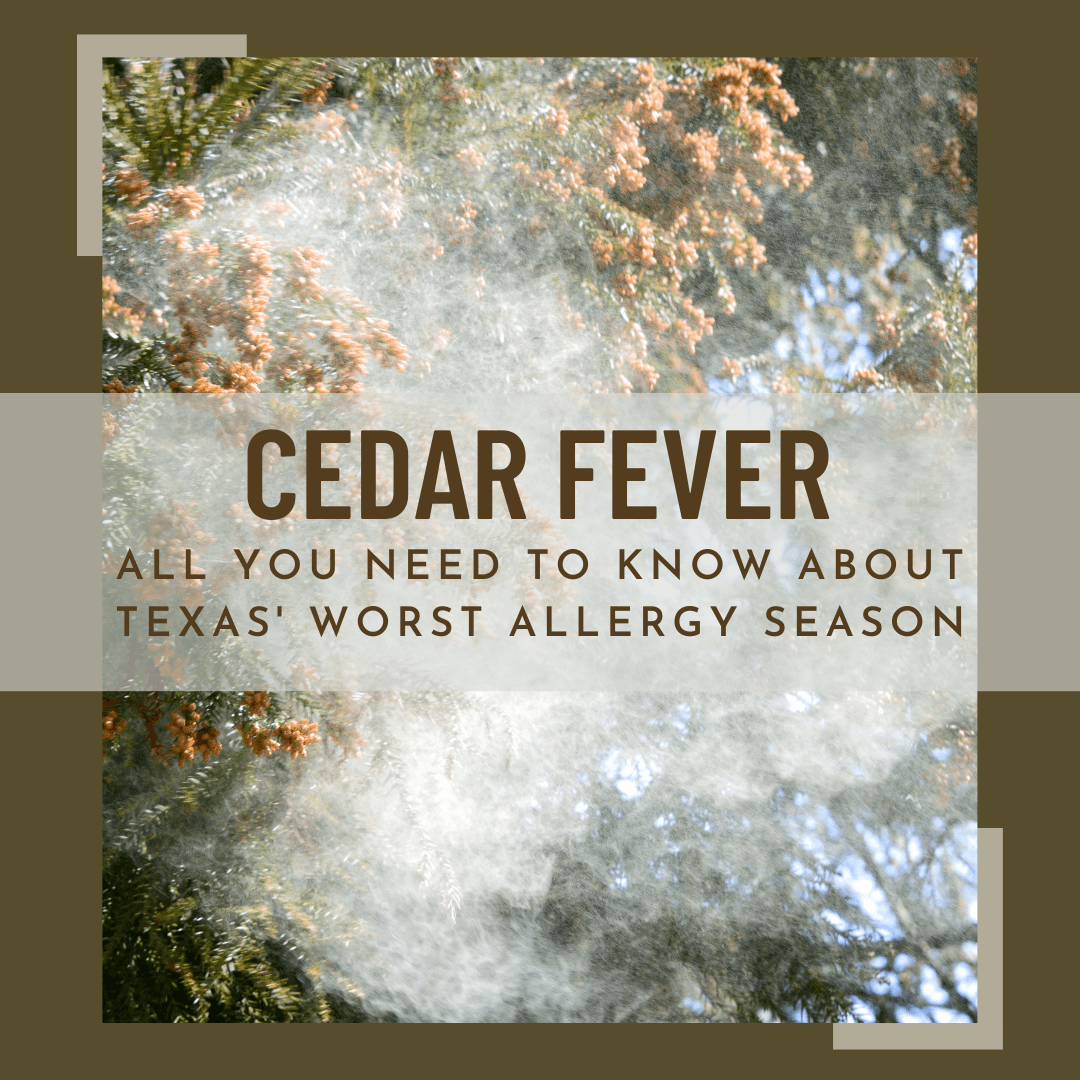Table of Contents
If you live in Texas, you've most likely heard of Cedar Fever or know someone who suffers from it. But what makes cedar allergies such a big deal? In this blog, we’ll dive deeper into what causes Cedar Fever, why it’s so bad for Texans and what you can do to reduce symptoms.
What is Cedar Fever?
Cedar Fever is an allergic reaction to pollen from trees located around Texas and the Southwest United States.
When is Cedar Fever?
The allergies usually begin with the first widespread freeze, usually around November or December, and can last until February or March. Cedar pollen usually peaks during January. Checking the pollen counts is the easiest way to see if that is what's bothering you.

Where is Cedar Fever?
Cedar Fever is primarily located around Texas, but can also affect those in Oklahoma, Missouri, Arizona, New Mexico and into Northern Mexico. Japan also experiences Cedar Fever from the Japanese Cedar or Sugi tree.

What symptoms does Cedar Fever cause?
Cedar fever symptoms may include:
- Nasal Congestion
- Runny Nose
- Sinus Pressure
- Itchy, Watery Eyes
- Sneezing
- Sore Throat
- Asthma
- Fever
- Fatigue
- Brain Fog
What causes Cedar Fever?
Cedar Fever is caused by the body’s reaction to the pollen from Ashe Juniper trees. Ashe Juniper trees are part of the Cypress family, but were nicknamed Mountain Cedar by European settlers who thought they resembled cedar trees of Europe.
Why are there so many cedar trees in Texas?
The largest population of Ashe Juniper is found along the Edwards Plateau. Originally, the area was covered with grass, due to the variability of the climate. Although it’s not clear how widespread Ashe Juniper Trees were in the Texas Hill Country before European settlers, there are two reasons they are so prevalent now.

When European settlers moved into the area, they began using the land for cattle and sheep grazing. Unlike the native wild bison, domesticated livestock did not forage efficiently or aerate the soil with their pointy hooves, thus wiping out the grass in the area. Most livestock do not like the taste of Ashe Juniper and will avoid it, allowing for it to take over.
Native Americans used controlled burns to encourage new growth of grass and eliminate other plants to entice bison to the area. European settlers did not commonly do this, which allowed Ashe Juniper trees to take over once the grass in the area had been eaten.
Where does cedar pollen come from?
The pollen comes from the cones of the male Ashe Juniper trees, while female trees produce cones that look like berries. Unlike most other trees and plants, Ashe Juniper trees begin the pollination season after the first large cold front of the year and continue pollinating throughout the winter months and even into March if there are still freezes occurring. Cold fronts also cause changes from low to high barometric pressure, which may also affect an individual’s reaction to the pollen.
Are cedar trees good for the environment?
Despite the negative attributes of Mountain Cedar, they do offer quite a few environmental benefits. An endangered species of bird called the golden-cheeked warbler uses the bark to build nests, as well as eating insects off the trees. They are the only bird that breeds exclusively in Texas, and mostly in the Hill Country. Other benefits include creating rich soil from the dropped leaves, helping to stabilize soil, creating homes for wildlife, providing berries for birds, deer, and other wildlife and acting as a host plant for Olive Hairstreak butterfly. Ashe Juniper wood is resistant to decay and great for making posts and other uses.
Is cedar pollen worse than other pollen?
Ashe Juniper pollen is not necessarily more allergenic than others, but combined with the change in temperature, pressure and wind can overwhelm the immune system. When Ashe Juniper trees start to pollinate, all the trees do so at once, causing a very high concentration of pollen that travels with the wind. Similar to Saharan Dust, the exorbitant amount of particles in the air can cause respiratory symptoms in those who don't normally experience any allergy symptoms.
What makes Cedar Fever worse some years?
The amount of rain received throughout the year can greatly impact the pollen output of most plants. Generally, higher rainfall means more plants which means more pollen. However, drought can cause the pollen to be more potent, in turn increasing allergic symptoms. The relationship between pollen and rain isn't quite as clear as it would seem.
How long does Cedar Fever last?
Cedar fever can last as long as cedar season, ranging from October through February. Symptoms can improve when cedar pollen counts are lower, such as rainy days; and get worse on days with high wind and warmer temperatures. Checking pollen counts can help you to know which allergens may be bothering you.
Why is Cedar Fever a serious issue?
Cedar Fever can become a serious issue for those suffering from asthma, respiratory issues, autoimmune diseases and immunodeficiencies. Many allergy sufferers report sinus infections and pneumonia every year due to the severity of their Cedar allergies.
How does pollution affect cedar allergies?
Studies show that pollution has greatly increased the number of cases of allergies and asthma throughout the world . Pollution has also been shown to increase the potency of pollen , with people living in urban areas experiencing higher levels of allergens than those living in rural areas.

How to tell the difference between Cedar Fever, COVID, the flu and a cold?
Cedar Fever symptoms can be very similar to flu, COVID and cold symptoms, as well as occurring during a season when the flu, colds and COVID are common. While fever can be a common symptom of cedar allergies, usually you will not experience a fever above 101.5ºF.

Do pets get cedar allergies?
Some pets experience allergies to ragweed, oak, cedar and grass pollen that are similar to humans. Although symptoms of cedar allergies may appear differently in animals. The most common symptom of allergies in dogs and cats is itchy skin, which can be localized to one area or to the whole body. Itching and biting incessantly can be a signal that your pet is experiencing an allergy. Respiratory symptoms such as coughing, sneezing and wheezing, as well as nasal and eye discharge are also common symptoms. Digestive symptoms, such as diarrhea and vomiting, can also occur. FYI: Your pets are also bringing cedar pollen into the house every time that they go outside.
How to prevent Cedar Fever?
While you may not be able to completely prevent your allergies, there are a few things you can do to help keep them controlled.
- Checking the pollen counts can be helpful for finding out what you're allergic to and being prepared on days when counts are high.
- Stay indoors on dry, windy days or avoiding spending too much time outdoors when pollen counts are high.
- Wearing a mask while outside or in an area with many cedar trees is the easiest way to physically reduce how much pollen you’re breathing in while outside.
- Using a HEPA filter in your HVAC system and air purifiers can help to reduce the amount of pollen throughout your home.
How to naturally reduce Cedar Fever?
Here are a few ways to keep your immune system from overreacting to cedar pollen:
- Lymphatic Drainage Massage can help to improve circulation throughout your body, as well as helping to flush your lymphatic system faster. Lymphatic Drainage can also help to reduce sinus pressure and headaches caused by allergies.
- Acupuncture and Chinese herbs are another great way to improve your immune system and treat allergy symptoms quickly.
- Homeopathic allergy formulations like Cedar X Formula and Cedar X® provide micro dosages of the offending problem and are designed to calm and improve your body’s ability to stay healthy. Not sure which one to use? Check out the differences between Cedar X Formula and Cedar X®.



